#bucranium
Text

~ Painted cow skull (bucranium).
Culture: Nubian
Period: Pan-Grave
Date: 1700–1550 B.C.
Mrdium: Bone and pigment
#ancient#ancient art#history#museum#archeology#ancient history#archaeology#nubia#nubian#pan grave#bucranium#1700 b.c.#1550 b.c.
561 notes
·
View notes
Text

Hadra hydria decorated in the black-figure technique with a bucranium flanked by swans in a panel between the handles and dolphins on the shoulder. The Greek inscription Dorotheou, 'of Dorotheos', incised above the bull's head, is the name of the person whose ashes this vase originally contained. Image by British Museum.
Learn more / Daha fazlası
Hadra Ware https://www.archaeologs.com/w/hadra-ware/
#archaeologs#archaeology#archaeological#dictionary#history#hellenistic#pottery#hydria#hadra ware#greek pottery#black figure#bucranium#swans#art#black-figure#arkeoloji#tarih#sanat
99 notes
·
View notes
Text
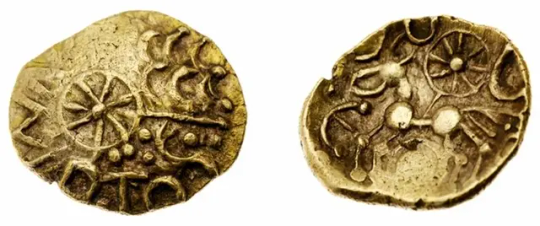
Gold Coin Reveals Unknown British King
New light has been shed on a little-known part of British history thanks to the extraordinary discovery of a coin bearing the name of a forgotten Iron Age ruler in Hampshire, south-east England.
The coin, which has the inscription “Esunertos,” was discovered by a metal detectorist in a field in Hampshire. Esunertos may have ruled as a king from the powerful Danebury Fort, according to experts’ speculation, and this find has been hailed as “one of the outstanding discoveries of recent decades.”
Leading Iron Age experts have studied the coin and deduced it to be struck by a pre-eminent male figure dubbed ‘IISVNIRTOS’ whose name translates as ‘Mighty as the God Esos’.
The coin was struck sometime between 50 and 30 BC, shortly after Julius Caesar’s first Roman raid of Britain in 55 BC.
The coin, which is thought to have been produced between 50 and 30 BC, was struck in conjunction with Julius Caesar’s first Roman raid on Britain in 55 BC when the Roman general and his 20,000 soldiers landed on the Kent coast. Despite a confrontation with Celtic warriors on the beach, the Romans encountered difficulties landing due to rough seas and eventually had to return home.
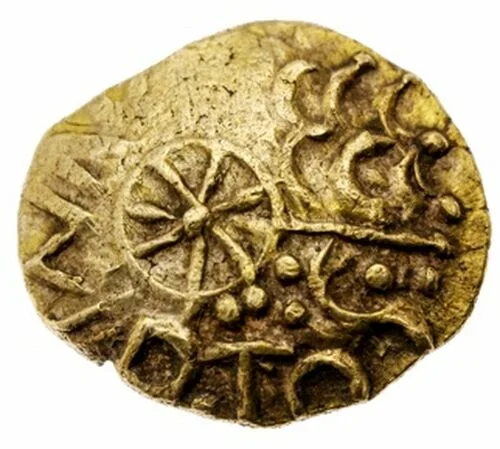
Gregory Edmund, Iron Age Coin Specialist at Spink Auctioneers said: “This fabulous piece of prehistoric artwork completes the mental image we have when we think of Iron Age Britain – the war horse and chariot.
“But it also surprises us with the appearance of classical languages like Latin.
Dr John Sills of the Celtic Coin Index at the Ashmolean Museum said: ‘It is one of the outstanding discoveries of recent decades in Celtic numismatics.’
Initially, it was anticipated that the gold coin would sell for around £4,000 ($5000) at auction. But contrary to all expectations, it broke a record at Spinks Auction by selling for an astounding £20,400 ($25,500).
The coin was found by Lewis Fudge, a metal detectorist who received permission to search a farmer’s field in March this year. Lewis Fudge expressed his elation, stating:
“I am over the moon. If it were not for people in the auction room, I would have jumped around. The collectors I spoke to are gobsmacked. I’m so glad I did not take them up on their private offers before the auction. To think my find has generated its own Wikipedia page is incredible.”
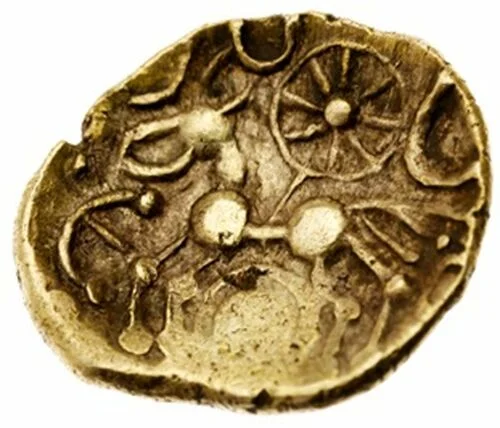
Spink Auctions describe the coin as a quarter slater with the obverse side of the coin bearing the name Esunertos in Latin, and with the worn head of Apollo formed of three interlocking rows of outward facing crescents, a seven-spoked wheel at center in lieu of the ear, and an eye of visage with radiating spike towards the neckline.
The reverse of the coin has a tripled-tailed horse, with a pincer-like mandible for face and linear ear, with pelleted mane, yoke or bucranium above the head, an 8-spoked wheel above spearing into the horse’s back, and double or triple ringed annulet below.
By Leman Altuntaş.

#Gold Coin Reveals Unknown British King#Hampshire England#Danebury Fort#Esunertos#gold#gold coin#ancient gold coin#ancient artifacts#archeology#archeolgst#metal detecting#history#history news#ancient history#ancient culture#ancient civilizations#iron age#celtic history
41 notes
·
View notes
Photo

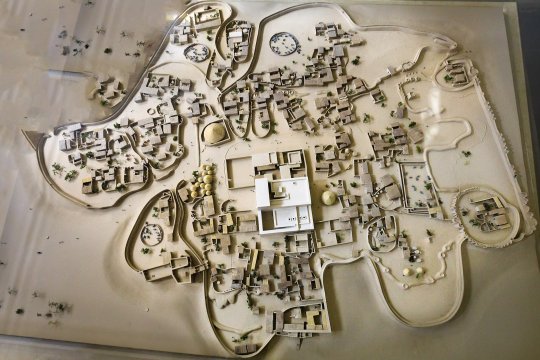
When is the first evidence of an African empire?
I will have to go with Kerma, below I’ll explain why .
The general political situation in the Neolithic Southern Nile Valley (left), pre-Kerma around c. 4th millennium BC (centre), and a Medjay warrior depicted on a bucranium (cattle skull) from Mostagedda, Middle Egypt, (right), illustrating the use of Hieroglyphs among the southern populations living among the Egyptians
See where Kerma is in the purple ? it would take all those other polities creating a large Empire to be known as Kush.
So if by Empire we are talking about a state gobbling up multiple states, many may think Egypt because the land area was large, but Kerma at it’s height took over all the surrounding polities under a unified front, I guess one could argue the same for the early unification of the upper and Lower Egypt, but these were multiple entities from as far away as Punt even.


The standing remains of a c. 4000 year old monument. The Western Deffufa, a massive mud brick temple in the center of Kerma, capital of the first Kingdom of Kush.
The rise of Kerma (c. 2500 BC) sees the absorption of these tribes into a strong centralised state, know as Kush, which ended up rivalling Egypt itself. This period sees some of the first monumental construction activities in Sudan, organised labour, advanced metallurgy, cross-continental trade networks and the earliest use of Egyptian hieroglyphs as well as being embroiled in violent conflict with their northern neighbour, annexing lower Nubia and raiding as far north as Thebes. A thousand years after its establishment, the Kingdom of Kerma was conquered by the New Kingdom. 500 Years of occupation blurred the lines between Kush and Egypt, as the material culture of the two countries became nearly indistinguishable.

Aerial view of a historic reconstruction of the central district of the Royal City of Kerma, somewhere around c. 2050 - 1750 BC, showing the Western Deffufa, a massive mud-brick religious monument, still standing today at 18 meters in height , surrounded by elite residential area's. This central area was walled with massive earthen ramparts with bastions. A large necropolis, shrines, palaces and agricultural villages extending north and south towards the fertile plain of the Nile surrounded this district.
The rise of Kerma (c. 2500 BC) sees the absorption of these tribes into a strong centralised state, know as Kush, which ended up rivalling Egypt itself. This period sees some of the first monumental construction activities in Sudan, organised labour, advanced metallurgy, cross-continental trade networks and the earliest use of Egyptian hieroglyphs as well as being embroiled in violent conflict with their northern neighbour, annexing lower Nubia and raiding as far north as Thebes. A thousand years after its establishment, the Kingdom of Kerma was conquered by the New Kingdom. 500 Years of occupation blurred the lines between Kush and Egypt, as the material culture of the two countries became nearly indistinguishable.

The following is important as to why I think Kerma was the first Empire.
The El Kab inscription
The tomb belonged to Sobeknakht, a Governor of El Kab, an important provincial capital during the latter part of the 17th Dynasty (about 1575-1550BC).
The inscription describes a ferocious invasion of Egypt by armies from Kush and its allies from the south, including the land of Punt, on the southern coast of the Red Sea. It says that vast territories were affected and describes Sobeknakht’s heroic role in organising a counter-attack.
The text takes the form of an address to the living by Sobeknakht: “Listen you, who are alive upon earth . . . Kush came . . . aroused along his length, he having stirred up the tribes of Wawat . . . the land of Punt and the Medjaw. . .” It describes the decisive role played by “the might of the great one, Nekhbet”, the vulture-goddess of El Kab, as “strong of heart against the Nubians, who were burnt through fire”, while the “chief of the nomads fell through the blast of her flame”.
The discovery explains why Egyptian treasures, including statues, stelae and an elegant alabaster vessel found in the royal tomb at Kerma, were buried in Kushite tombs: they were war trophies
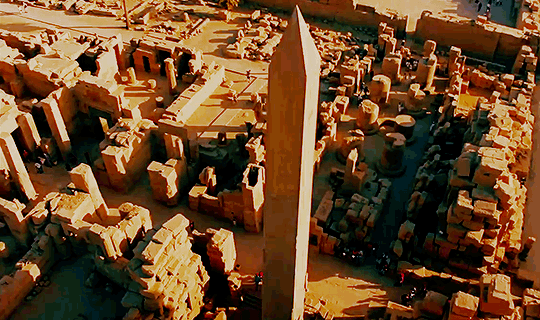
#ta seti#nubi#kemetic dreams#north africans#north africa#northeast africa#punt#kerma#egypt#ta meri#kemet
40 notes
·
View notes
Photo

The Parade Enfilade of Quarenghi - Alexander Palace, Tsarskoe Selo (1909-1910)
In the Collection of Yale University, as many know, is the Beinecke Rare Book and Manuscript Library. Part of this collection comes in the form of several photograph albums and a good deal of written letters, etc. These albums which were brought over by Anna Vyrubova, one of the Empress’s ladies-in-waiting give a rare glimpse into the private life of the Imperial Family. These photographs were not meant for public eyes, however they’ve been digitised regardless of this.
In Album No. 4, on page 40 of this album is a photograph which was taken in the Parade Enfilade which was designed by Giacomo Quarenghi, and of the Palace, is part of the original, surviving interior decoration from the mid-1790′s (1796). The view shows the Enfilade looking from the Portrait Hall, through to the Marble Drawing-Room (formerly a billiard-room during the reign of Tsar Nicholas I).
It’s interesting to note that some furniture pieces have protective dust covers on them. Also of note are some of the live plants which populated this series of state halls during when the Imperial Family was in residence at Tsarskoe Selo. It is likely that the photograph was made during the “shuttering” of the Palace for when the Imperial Family went on holiday or were visiting other countries, or when they were just returning.
Usually, large carpets and rugs were laid out and tall palm trees (of 13 feet in height) stood between the four sets of columns and pilasters which split the Enfilade up effectively into three halls. These palm trees, including a fretwork of greenery (which can just be seen between the column and pilaster (to the right, by the covered grouping of furniture in the back-ground), and a date palm (of no more than 10 feet) which sat on a pedestal, normally decorated the Parade Enfilade. In the Portrait Hall, at the four corners of the room were kept tropical greenery in galvanized, steel basins - one of which can be seen at the left corner, mentioned above.
Also of note is the furniture of the Parade Enfilade which was a mélange of antique and more newer pieces. In the Portrait Hall, were kept a variety of furniture pieces ranging from a suite from a set of furniture designed by Georges Jacob which was kept in the Arabesque Hall of the Catherine Palace, to a newer set of similarly-designed furniture of white and gilding (by the firm of N. Svirsky) which was used interchangeably with the Jacob Suite when the Imperial Family were in residence. Along with these pieces were gilded, wooden-framed chairs from the Chinese Theatre, several of which can be seen through-out the hall, including a crowd of them surrounding a table with a long table cloth. At fore-ground is a gilded, bucranium head’s table with a marble top and hooved feet with one of the Jacob chairs. This table was one of several made by the Svirsky Firm for the Empress’s Corner Drawing-Room. Along with this table, were two lapidary tables of variegated blue stone and gilding, also from the Catherine Palace, executed in the Louis XVI style during the reign of Empress Catherine II by the Peterhof Lapidary Works.
In the adjoining Semi-Circular or Oval Hall (as it was also called), were a set of 48, Russian Empire style beechwood chairs which were enameled and decorated with gilded ornamentation typical of the Empire style. In 1909, the design of these chairs, by the Court Architect, Silvio Danini was executed by the firm of F.F. Meltser & Co., a firm synonmous with the last Tsar of Russia’s reign.
At the end of the Parade Enfilade (before one moved into the more private house chapel (formerly the Raspberry Living-Room of Empress Alexandra Feodorovna (Charlotte of Prussia)), the furniture suite of the Marble Drawing-Room consisted of pieces which were manufactured between 1830-1840, respectively. This suite of furniture, sculpted in mahogany with gilded ornamentation, was originally kept in the Concert Hall (which had been demolished in early 1902). Among this suite of furniture were also gilded, wooden-framed chairs which also had been in the Concert Hall, previously. These chairs can be seen in the photograph of the Parade Enfilade (Circa. 1909), and one of the autochromes of the Marble Drawing-Room (Circa. September 1917).
Despite the carnage and savagery of the Second World War, and prior to, the selling of the objects and works of art by the Soviet government during the period when the Palace was a museum (1918-1941), quite a few pieces of the furniture suites which decorated the Parade Enfilade have survived.
Currently, GMZ Tsarskoe Selo is in the process of a large-scale reconstruction and restoration project which is seeing to the restoration of elements of Quarenghi’s beautiful state apartments. It is planned for the project to be fully complete no later than 2024.
________________________________________________________________
Photographs:
1. Parade Enfilade of the Alexander Palace.
Sources:
Beinecke Rare Book and Manuscript Library, Album No. 4
Link of courtesy:
https://collections.library.yale.edu/catalog/4
#alexander palace#tsarskoe selo#gmz tsarskoe#1909#1910#giacomo quarenghi#anna vyrubova#silvio danini#meltser#furniture#plants#georges jacob#russian archival material#yale university#beinecke collection#photographs#chairs#table
7 notes
·
View notes
Photo

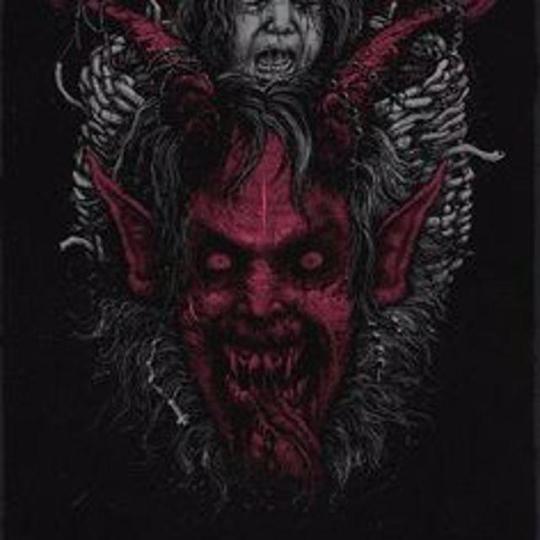


Krampus Rising
As the sun goes down...
The Bells of Hell resound
The Gates are open... tonight
Emerging from the frost, they come
Nightmares unleashed
Across the earth, shadows rise
For a season at a time
From Hallow's Evil to Yuletide
In the darkness of the mind
Scraping claws
Grinding jaws
Horns arching to the sky
Hissing brimstone, howling winds
Unholy procession
Demonic possession
Bonefire torchlight
Lanterns of The West
KRAMPUS RISING
Whips & chains
KRAMPUS RISING
Dragging souls to Hades' flames
Earth quake hooves
Closer... behind... closer... nearer
The hoofbeats of your heart
Hypnogogic gaze
Osculation graze
Feasting on the nubile flesh
Trick or treated as you may
Red eyes glowing in the night
Filling hearts and minds with fright
Infernal blessing of the birch
Bloodied by the sacrifice
Before the dawning
Into the Pit as black as pitch
Leaving The Devil's mark
Forever taken away
KRAMPUS RISING
Up from Hell
KRAMPUS RISING
Casts The Spell
KRAMPUS RISING
Hear the bells...
...Fear the bells.
Under The Krampus Moon
Hellfires burn... The scent of flesh
Wailing on the demonwinds
The beatings of Abyssal skins
Echoing of bones
Blood upon the bramble thorns
Trailing to the foggy Pit
The bells are rung...
Chains echo from below
Krampus Demon, Winter Devil
Eyes aglow in the dark
Outside your window haunt
Prepare the sacrifices
The saintly one denies
Hellmouth opens wide
Into The Cauldron, Feast of Beast
Offering complete
Beneath Krampusnacht Moon
Hills of fire, build the pyre
Bodies on the spikes
Dread shadows arise
Cloven hooves arrive
Upon Krampus night
Unholy procession
Through the snow and flames
Calling to your name
Pentagram of blackened coal
Brimstone, sulfur soul...
Inferno rejoice tonight
A nubile harvest of plight
Devoured and enslaved
Beware those phantoms in the shadows
Branded with The Devil's mark
A lesson learned of fear and dread
Or never to be seen again
Beneath The Krampus Moon
Krampusfyre!
Howling Winds, through Hellmouth rise
Icicle fangs, hearth glowing eyes
Melting snow, a whip of flame
Hoofbeats from The Pit, torches light the way
Scraping claws, gaping jaws
Serpentine probing tongues
Savor the carnage faire
Bloodthorns lashing deep
Bucranium Staves pound the earth
Demon shades lurching forth
Crown of Horns arching high
From Krampusnacht they ride
Ornaments shattered
Trees ignite the pyre
Church mangers & temples ablaze
kindling nazarene, kringle chained
Chaotic Krampus Fyre!
Venison sacrifice, skeletal remains
Feast of The Beast, Solstice Sabbath beckons
Nativity Offering, Black Mass eve/il
Mithras! Horus! Dionysis!
Follow the Lucifer star!
Shadowy demonic forms quake through the snowy wilderness, their black reflections stretching forth across the land by the flickering of hellfire burning atop staffs with skulls crowning. They emerge to cause chaos and rampage from nightmare fane, immolating herdmas decorations in their wake. These avengers from Hell take their sacrifices to consume as they may. They have come forth upon Krampusnacht and have celebrated upon The Solstice Sabbath, now to destroy the nazarene's foul denizens as part of the Black Mass. Demon's Night upon the eve. Let the hellfires burn! ∞
*
Information
:
Krampusnacht
: 12/5,6. ∞
"Krampusnacht", or "Night of The Krampus" takes place on the eve of "St. Nikolas", making it a sort of its own Halloween observance, wherein the demons come forth in pageants and parades bearing torches, thorned birchreeds, horns, claws, fangs, demonic beasts all! Sometimes even seen upon infernal thrones! These are folkorically intended to frighten the populace {especially children} into behaving themselves, to remain "virtuous" as a last chance, so that St. Nick will reward them with presents and treats on the 25th {actually Moloch & Dionysus/Pan's Birthday!}. Santa Claus usually makes an appearance at the end of the parade dressed like a Bishop with a mitre.
So, for the last vestiges of blessed Autumn, these demons make sure Halloween & Autumn are represented all the way up to Winter Solstice!
In traditional depictions, Krampus is sometimes seen riding along with Nikolas on the sled for punishments due, a flogging, spanking, and leaving coal instead of pastries & candy. This tradition thrives primarily in the Northern climes, though there certainly are comparisons in other nations as well, such as Japan, who has the "Namahage", and increasingly so more present even in The West!
An Olde Testament correlation can be made with Satan {"Accuser"} seated at the left hand of "God", whose purpose was said to accuse sinners of misdoings, likened the story of Job. Of course, subsequent 'Devilutions' have included a myriad of purposes and darketypal incarnations.
However, Satanists can acknowledge these beasts from Hell as veritable brothers and friends who reward the exploits of the Strong, the daring, the lustful, and the fiendishly clever with carnal delights! Krampus may be seen as a sort of "Satan Claws", as it were, and those who prefer to enjoy the Yuletide unholydays with demonic decorations more complementary & resonant of ourselves. The face of Satan dwells behind the indulgent mask of Santa, and it is seen as no small coincidence that the Satan & Santa anagram are frequently rearranged! ∞
[For more on winter traditions, see The Dark Side of xmas]
4 notes
·
View notes
Photo

Bringing the beauty of our lodge to light. Bucranium was a decoration commonly used in Classical architecture. The name originated with the practice of displaying garlanded, sacrificial oxen, whose heads were displayed on the walls of temples, a practice dating back to Neolithic times where cattle skulls were overlaid with white plaster. The OxSkull symbolizes the roman concept, Momento Mori, a reminder that death is eminent so live your life well. The symbol of the sacrificial Ox also reminds us that we must respect the animal lives we take in order to live. In older times the eaters of cattle would pray to absorb the ox’s spirit to live through them, providing them with greater strength to till their lands. The symbol of the Ox was a hopeful one, revealing a secret of this world. The soil where the cow’s milk and bull’s blood were spilled became incredibly fertile from the the concentration of minerals. And God showed grace when the ground grew lush with flowers, vines and vegetables. The particular Bucaranium on our lodge is molded after a more refined version found in Italy, the bleached skull representing purity, the light blue veil subconscious, the soul of man, the collective soul of men and the thin veil between conscious reality and the greater truths, the gold background representing the possibilities of perfection or enlightenment. The lodge decided to paint them in their traditional colors since most people hadn't even noticed them, to bring respect to the careful choice, the skilled labor that went into them and to beautify our neck of Astoria. #masonicsymbol #masonic #freemason #astoriaqueens #freemasonry #masoniclodge #masonichall #masonictemple #truth #architecture #masonicarchitecture #bucaranium #momentomori (at 30th Ave Astoria, Queens) https://www.instagram.com/p/Co5uwHNPHLB/?igshid=NGJjMDIxMWI=
#masonicsymbol#masonic#freemason#astoriaqueens#freemasonry#masoniclodge#masonichall#masonictemple#truth#architecture#masonicarchitecture#bucaranium#momentomori
1 note
·
View note
Link
Check out this listing I just added to my Poshmark closet: Wishful Park womens blouse size M bucranium print cow skull floral 3/4 sleeve.
0 notes
Text
Somewhere in Comox, #cowskull on the wall. ..#selfie #weekend #sunny #saturday #bullskull #bucranium #skull #bone #barn #farm #diablo #death #comox #vancouverisland #bc #canada - from Instagram
Somewhere in Comox, #cowskull on the wall. ..#selfie #weekend #sunny #saturday #bullskull #bucranium #skull #bone #barn #farm #diablo #death #comox #vancouverisland #bc #canada – from Instagram
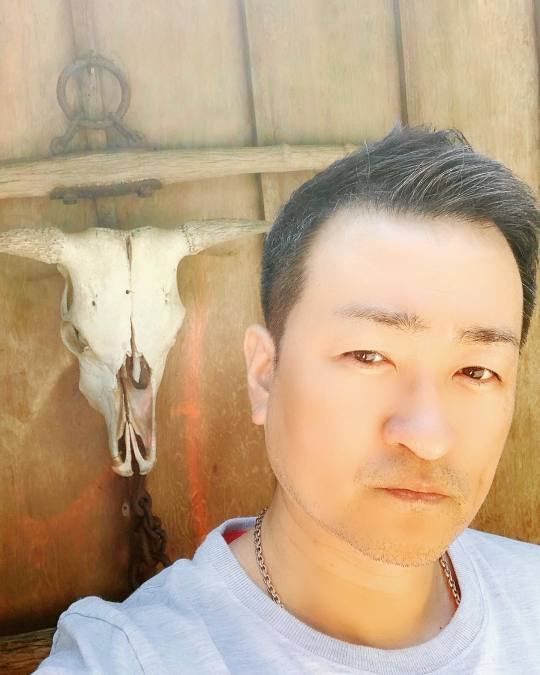
View On WordPress
0 notes
Photo

..
#rome#ancient#roman art#relief#Bucranium#traveling#rom#vertical#reise#travel#antik#photography#roma#travelling#reisen#sculptural#bukranion#archaeology#archäologie#roman#römisch#art#kunst#sculpture#skulptur#ornament#ornamental#archaeological museum#museo nazionale romano#antiquity
13 notes
·
View notes
Text

~ Bucranium.
Period: Second Intermediate Period, 17th-14th Dynasty
Date: ca. 1640–1550 B.C.
Place of origin: Egypt
Medium: Horn, bone, paint
#ancient#ancient art#history#museum#archeology#ancient egypt#ancient sculpture#ancient history#archaeology#Egyptian#egyptology#egypt#bucranium#14th Dynasty#17th Dynasty#second intermediate period#horn#bone#ca. 1640 b.c.#ca. 1550 b.c.
211 notes
·
View notes
Photo

• #bucranium Trabalho autoral para a querida Gabi, uma ideia muito legal, em um estilo muito gostoso de fazer. O crânio de boi é um arquétipo fortíssimo, que é associado desde a vida longa, como também proteção contra todos os elementos naturais e seus perigos. Fora que tem tudo a ver com a profissão dela. Muito obrigado pela oportunidade, Gabi! 🖤 • Quer fazer a minha ou a sua ideia? 😉 • Para orçamentos e agendamentos, entre em contato pelo WhatsApp 31 993378298 (link do WhatsApp na Bio) #tattoo #tatuagem #tattoo2me #radtattoos #blackwork #ink #besttattoos #belohorizonte #contagem #minasgerais #bh #mg #br #jacksontakeda #tatuaje #tatuaggio #oxskull #bullskull #bull # (em Belo Horizonte, Brazil) https://www.instagram.com/p/Ca5gsymu_VQ/?utm_medium=tumblr
#bucranium#tattoo#tatuagem#tattoo2me#radtattoos#blackwork#ink#besttattoos#belohorizonte#contagem#minasgerais#bh#mg#br#jacksontakeda#tatuaje#tatuaggio#oxskull#bullskull#bull
0 notes
Photo

Frau und Stierschädel , Bleistiftzeichnung
woman and bucranium, pencil drawing
1 note
·
View note
Video
Turtle ant mimic crab spider, Bucranium sp. by Andreas Kay
Via Flickr:
from Ecuador: www.youtube.com/AndreasKay
#Amazon#Andreas Kay#Arachnida#Bucranium sp.#crab spider#Ecuador#focus stack#Pastaza#rainforest#spider#Thomisidae#Turtle ant mimic crab spider
29 notes
·
View notes
Text
bovine themed names
Abigar (Abigar cattle)
Albion (Blue Albion, british breed of cattle)
Ankole (Ankole cattle)
anteng,javani,vanicu,tembad (Banteng/Bos javanicus/tembadau, cattle from southeast asia.)
antiqu (Bison antiquus, ancient bison from North America)
Asteri (crete name for minotaur)
athaba (American wood bison, Bison bison athabascae)
Auroch (Aurochs, a primitive cow)
Boskap, odbrok (Swedish Red Pied/Rödbrokig Svensk Boskap, a swedish cow)
Braunv, unvieh (Braunvieh, brown cattle from germany)
Bubalu (Bubalus arnee, wild water buffalo)
Buchis (Buchis/bakh/bakha ancient egypt sacred bull)
Bucran (bucranium, depiction of the skulls of ox in classical architecture)
Bugoni, bougon (bugonia/bougonia, ritual based on a cow carcass)
Camahu, mahuet (Camahueto, calf or bull with a small horn on its forehead from Chilote mythology)
Charol, rolais (Charolais cattle from france)
Damona (Damona, cow goddess worshipped in Gaul)
daquit, quitai (Blonde d'Aquitaine cattle from france)
eliobo (Cattle of Helios/ Ἠελίοιο βόες, Ēelíoio bóes, cattle on the island of Thrinacia)
Enkidu (wildman figure in Mesopotamian mythology)
gaurus (gaur/Bos gaurus, Indian bison)
Gertru (Santa Gertrudis cattle)
geushu (geush urva, "the spirit of the cow")
Girola, olando (Girolando cattle)
gudali (The Bison-beast, a hero slain in sumerian religion)
Haddad (Adad/Haddad/Hadad/iskur storm and rain god Mesopotamian religon with the symbolic animal of a bull)
Hadhay (Hadhayans, Zoroastrian mythological bovine)
Hamiti (Hamitic Longhorn, the origin species of highland cows)
hanaiz,zumien (Bison hanaizumiensis, japanese bison)
Hapian (Apis/hapis/Hapi-ankh, bull worshipped in ancient egypt)
Hathor (Hathor, egyptian cow goddess)
hazaha (golden calf/ēggel hazāhāv, idol made by the israelites)
heifer,adumma (Red heifer/para adumma, virgin cow made for sacrifice)
Herefo (Hereford cattle, british breed of beef cattle)
Hostei, Friesi (Holstein Friesian cattle)
ikaner (Afrikaner cattle)
Ilawar, awarra (Illawarra cattle from Australia)
Jaktor (the name of the forest the last auroch's died in)
Jallon, Malink, nadama (N'Dama, Boenca or Boyenca (Guinea-Bissau), Fouta Jallon, Djallonké or Djallonké cattle, Fouta Longhorn, Fouta Malinke, Futa, Malinke, Mandingo (Liberia), and N'Dama Petite)
Kamadh,Surabh (Kamadhenu/Surabhi bovine goddes in hinduism)
Kankre (Kankrej cattle)
laeosi,nensis (bison palaeosinensis, early bison)
Lamasu (lama/lamma/lamassu/shedu, Assyruian protective diety)
leborn, huidre (Lebor na hUidre [ˈl͈ʲevor nˠə huiðʲrʲə] or the Book of the Dun Cow)
lekijn (boelekijn/bullock, a young bull)
Limous, mousin (Limousin cattle from france)
Mehete (Mehet-Weret, "Celestial Cow" or "Cow Goddess" in ancient egypt)
Mnevis (ancient Egyptian bull god)
Moloch (Moloch/molech/molek, bull-headed idol appearing in the hebrew bible)
Nandiu (nandi, gate guardian diety in the hindu religion)
niutou (ox-head, one of two guardians of the underworld in Chinese mythology)
ociden (Bison occidentalis, extinct species of bison from North America)
oumbla (Auðumbla, primeval cow from norse mythology)
ovidae (Bovidae, the family of bovines)
pongif, cephal,halopa (Bovine spongiform encephalopathy, mad cow disease)
priscu (B.priscus, steppe bison)
rakens (Drakensberger cattle)
rangus (Brangus, cross between angus and brahman breeds)
rontal,mithun (gayal/Bos frontalis/mithun, indian domesticated bovine)
Sahiwa (Sahiwal cattle)
schoet,tensac (Pleistocene woodland bison, B. schoetensacki)
Senepo (Senepo cattle)
Taurin (Taurine cattle, domesticated species from europe)
Taurob (Taurobolium, practices involving the sacrifice of a bull)
tifron (Bison latifrons, giant/long horned bison)
Trigar,garanu (Tarvos Trigaranus, divine fingure in a roman monument)
uzerat, Guzera (Guzerá cattle)
Vechur (Vechur Cow)
wisent (European wood bison)
zerwon (Polish Red, Polska czerwona)
zubron (a hybrid of domestic cattle and bison)
19 notes
·
View notes
Text
wip whenever
Thank you for tagging me @pinkfadespirit!
I've been bopping all over the place with my writing this week, going back to old works that have been languishing in the WIP folder for months and adding little bits or changing sentences. Here's some new stuff for that fic I started writing ages ago about Anders' first and last kisses with the important people in his life (heads up for physical abuse):
The fight drains out of Anders the moment the Circle’s massive oak doors slam shut behind Karl. He sags in the templar’s grip with a sob, and they throw him to the ground. He’s near silent when they beat him right there in the hallway, his tears splashing onto the stone as they slam armoured fists into his middle. They’ve done far worse before - physically, anyway. The scars criss-crossing his back are a testament to that.
When they’re done, Niall rushes over to help him down to the infirmary. Wynne’s expression is a mix of disappointment and pity as she heals his dislocated shoulder and broken ribs. She tells him they took Karl to Kirkwall - the Gallows was in need of “fresh talent”. What a load of shit. Karl’s a talented enchanter, but he was only Harrowed two years ago. No, Anders knows the reason they took Karl over a more experienced mage. It was to punish him and Anders both, he’s certain of it.
And a non-writing WIP - I've been cross-stitching Anders' bucranium that's the icon for his specialization. Once I'm done with the black, I'm going to do a yellow background, and then move on to doing basically the same thing for Fenris' specialization icon. And then I'll probably need to pick up more thread, and I'll look at doing Merrill, Isabela, Varric and one of the icons from the blood mage tree.


Tagging, with absolutely no pressure: @barbex @5lazarus @blarrghe @protect-him
5 notes
·
View notes